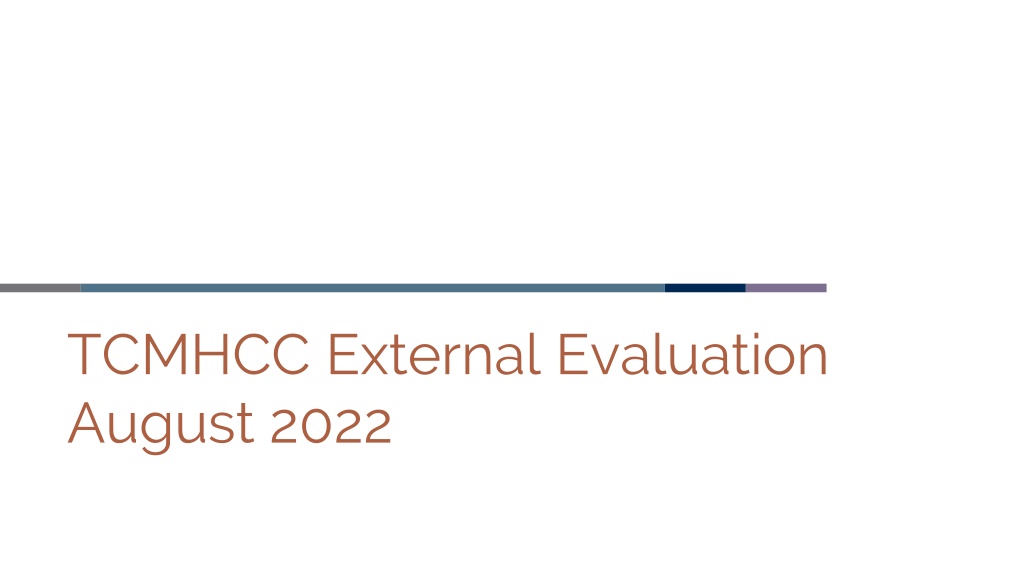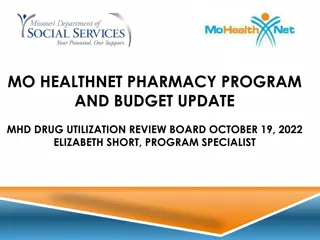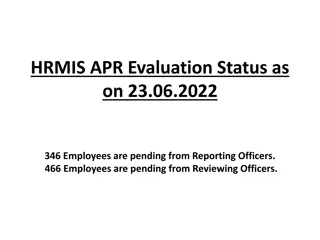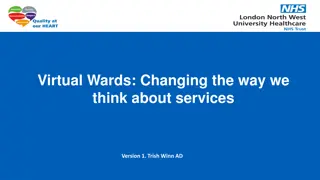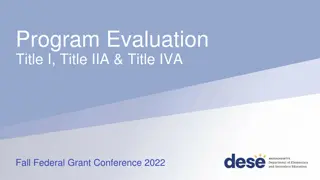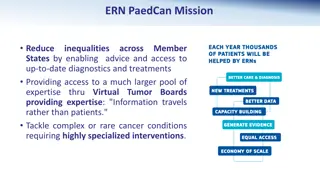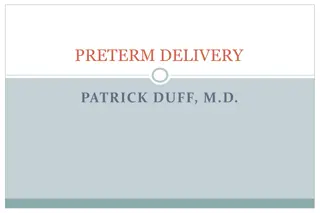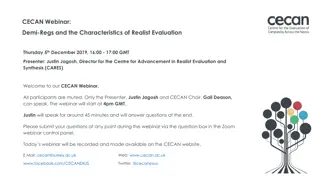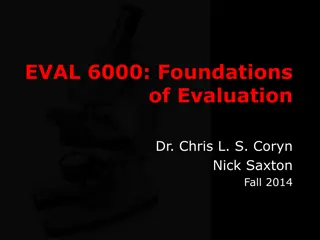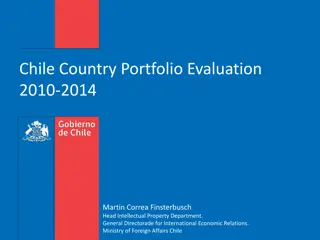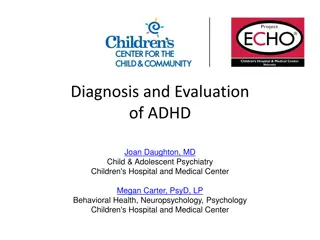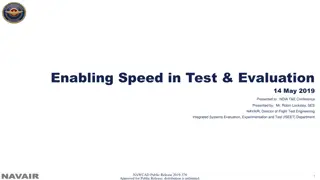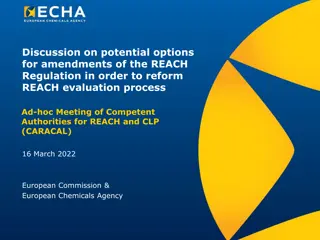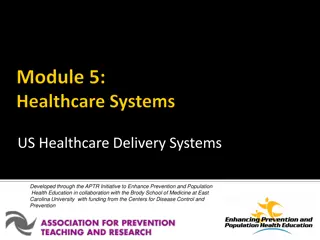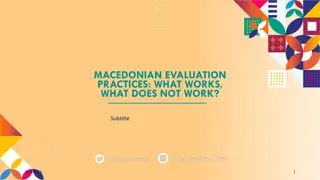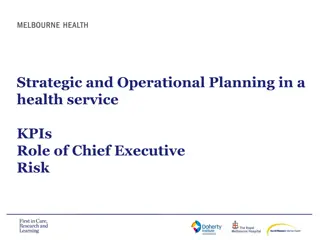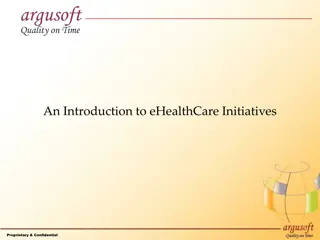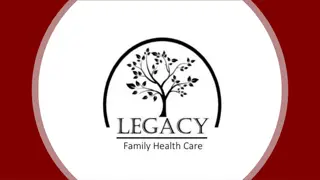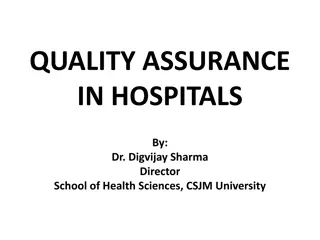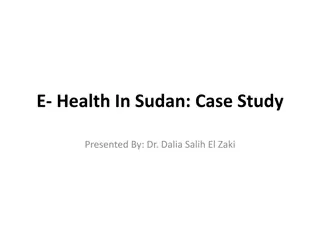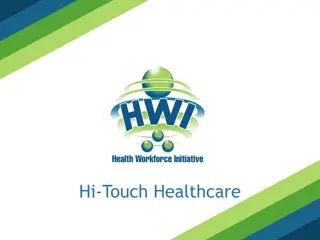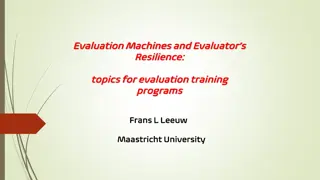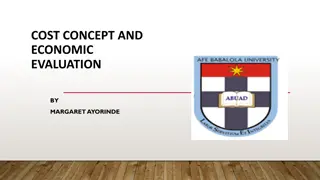Healthcare Evaluation and Service Delivery Insights - August 2022
Insights from various healthcare assessments and service delivery data including clinic staff enrollment, CPAN consult reasons, TCHATT session characteristics, and more. The data provides details on clinic and school district enrollment and reach, service delivery characteristics, intervention types, and vulnerability indicators.
Download Presentation

Please find below an Image/Link to download the presentation.
The content on the website is provided AS IS for your information and personal use only. It may not be sold, licensed, or shared on other websites without obtaining consent from the author. Download presentation by click this link. If you encounter any issues during the download, it is possible that the publisher has removed the file from their server.
E N D
Presentation Transcript
TCMHCC External Evaluation August 2022
CPAN: Clinic/Clinic Staff Enrollment & Reach Percentage of Enrolled CPAN Clinics by County-Level Characteristics 2013 RUCC Codee 2013 RUCC Codec Metro Metro Non-Metro Non-Metro Rural Rural SVI Scoresf SVI Scoresd <0.2 (least vulnerable) < 0.2 0.2 - 0.4 0.2 - 0.4 0.4 - 0.6 0.4 - 0.6 0.6 - 0.8 0.6 - 0.8 0.8+ (most vulnerable) 0.8 + 0.0% 20.0% 40.0% 60.0% 80.0% 100.0% a b CPAN-Enrolled Clinics (N=1482) Texas-Wide Clinics (N=8024) Data sources: (a) Trayt CPAN Clinic and Clinic Staff Directory (May 1 2020-April 30th, 2022). 4 clinics missing RUCC codes (USDA could not calculate the RUCC code). (b) List of providers (adolescent medicine, family medicine, pediatrics, internal medicine, general practice) in Texas purchased from the Texas Medical Association by COSH. (c) 2013 Rural-Urban (RUCC) Continuum Codes, USDA Economic Research Service, U.S. Department of Agriculture. RUCC Codes: 1-3 = Metro; 4-7 = Nonmetro; 8-9 = Nonmetro, completely rural. (d) County-level social vulnerability index data from the CDC, 2018 (SVI-2018; http://svi.cdc.gov/). 2
CPAN: Service Delivery Reasons for CPAN Consults (N=9,579)a General Resources Referral Assistance Medication Management Diagnosis Assessment Call Reason 0 1000 2000 3000 4000 5000 6000 Total CPAN Callsb (a) Data Source: CPAN Encounter-level Extract, Trayt. April 30th, 2022. (b) Providers may report more than 1 reason for calling. 3
TCHATT: School District Enrollment & Reach Percentage of Enrolled TCHATT Campuses by Geographic and Population-level Vulnerability Indicators Campus Size Campus Size < 500 < 500 500 - 1000 1000 - 1500 1500 + 500 - 1000 1000 1500 1500+ TEA Rural/Urban Codes TEA Rural/Urban Codes Rural Urban Urban Rural % Economic Disadvantage % Economic Disadvantage <70% 70% + >70% < 70% 0.0% 20.0% 40.0% 60.0% 80.0% 100.0% b a Texas-Wide Campuses (N=9653) Enrolled Campuses (N=3215) (a) Data Source: Texas Education Agency Campus, District, and District Snapshot Data (b) TCHATT Campus Data, provided by COSH (September 1st 2021-June 30th, 2022) 4
TCHATT: Service Delivery Characteristics of TCHATT Sessions (N=28,585) HRI Provider Type Care Provided by HRIs 41.5% LPC/LMHC 41.0% Assessment 26.1% LCSW/LMSW 16.4% Psychologist 12.1% Standardized measure 11.1% Psychiatrist 4.3% Nurse Practitioner 10.1% Medication management 0.8% Physician Assistant 0.0% 10.0% 20.0% 30.0% 40.0% 50.0% 0.0% 10.0% 20.0% 30.0% 40.0% 50.0% % Completed TCHATT Sessions % Completed TCHATT Sessions 5
TCHATT: Service Delivery Top 5 Intervention Types Among Completed TCHATT Sessionsa Reasons for TCHATT Referral Appetite/Eating 40.6% Supportive Therapy Depression 46.3% 33.7% Anger/Violence/Aggression 21.5% Cognitive Behavioral Therapy Attention Problems 39.3% 20.4% Disruptive Behaviors 17.6% Case Management Substance Issues 22.2% 16.4% Suicidal Thoughts 16.4% Psychosocial Education Academic Issues/ Truancy 12.4% 15.9% Harm to Others 15.6% School-based Coordination Low Self Esteem 10.5% 13.7% Bereavement or Grief 9.2% 0.0% 20.0% 40.0% 60.0% 80.0% 100.0% % Completed TCHATT Sessions Anxiety/Excessive Worry 7.9% Self-Harm 7.8% Bullying 6.5% aTrayt Session-level Extract (September 1st 2021-June 30th, 2022) bTCHATT Sessions may include more than one intervention type 0.0% 20.0% 40.0% % Enrolled Referrals 60.0% 80.0% 100.0% 6
TCHATT: Service Delivery Reasons for Terminating TCHATT Services Among Closed TCHATT Casesa (N=3939) 9.3% 20.1% 57.9% 12.7% No further treatment required/goal completion Unable to reach patient or parent/guardian Declined continuation of service Missing end of service reason a Trayt Referral-level Extract (September 1st 2021-June 30th, 2022) 7
External Evaluation Activities CPWE Interviews Conducted interviews with 11 CPWE residents Analyzing qualitative interviews to understand residents perspectives of benefits, challenges, and potential influence of the CPWE training program on professional development TCHATT & CPAN Surveys Surveying a diverse sample of school districts/campuses (TCHATT) and clinics (CPAN) across HRIs to understand contextual factors influencing program engagement and implementation Data collection : June-August (TCHATT survey); August-September (CPAN survey) Cost Analysis Developed instruments for evaluating the cost of CPAN and TCHATT program implementation Data collection: HRI worksheets (early September); CPAN & TCHATT surveys (in process) HRI Evaluation Packets Developed packets for HRIs with results of Year 1 external evaluation Will disseminate to HRIs in September 9
